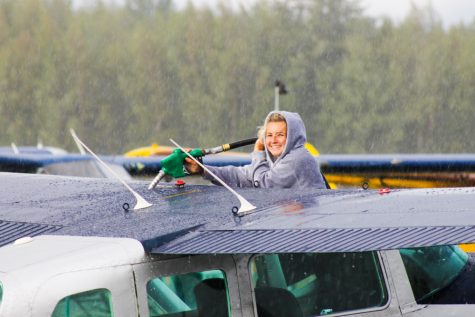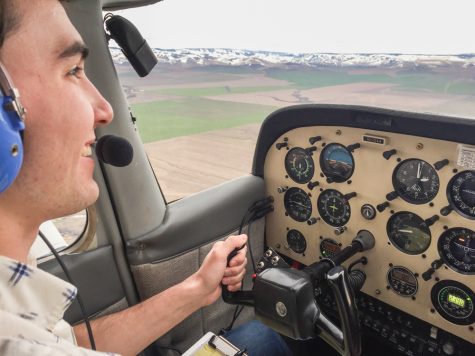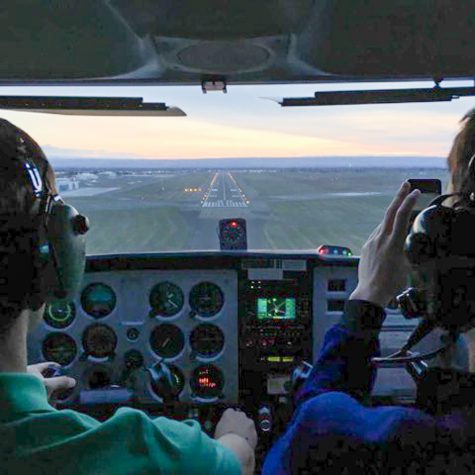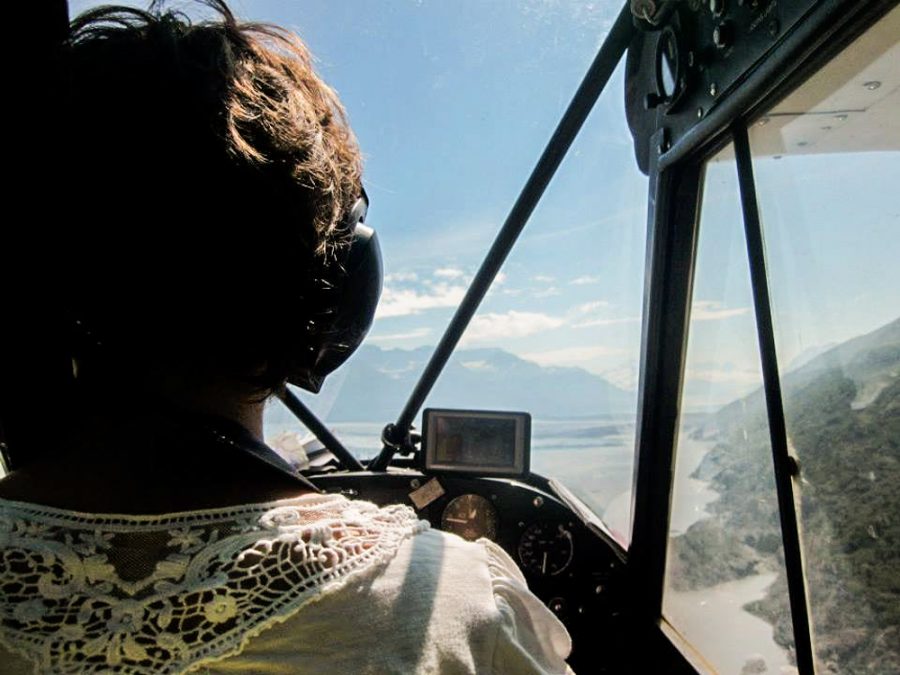Classroom in the Clouds
“This photo was taken the day I got a traffic infraction,” said Isabel. Contributed by Isabel Mills.
March 9, 2017
A handful of Whitties–along with around fifty students at Walla Walla University (WWU) and various members of the Walla Walla community–attend class thousands of feet above their peers. In combination with a grounds school taught in a traditional classroom setting, students get a hands-on opportunity to fly small planes through the Walla Walla University Flight School.
The Start of Something New
Senior Isabel Mills first stepped into a plane at the age of fifteen years old in her hometown of Anchorage, Alaska. She snagged her pilot’s license as soon as she graduated from high school.
A lot of Alaska is only accessible by plane, so Mills mentioned that Anchorage houses a huge community of pilots. Her dad was a doctor and would fly for fun on the weekends along with other doctors. Since she had grown up surrounded by planes, learning to fly became less intimidating for her.

“I was exposed to the community and comfortable with it,” Mills said.
Once Mills had a glimpse of the flying community, she put her decision to pursue flying at full-throttle.
It wasn’t easy.
As designated by the Federal Aviation Administration (FAA), all pilots must pass a written exam, medical exam and a checkride with a pilot examiner. Pilots have to complete forty hours of flight time, ten hours of solo flight time and three hours of cross-country flight time. Night flying is also required, but in Alaska it is waived over the summer because the hours of nighttime are very limited.
However, it was worth it.
“Then you’re above everything. It gave me a new perspective on how my city was laid out because I was able to see everything,” Mills said. “And not only my city, but the surrounding area. You get to see things that you wouldn’t ever see otherwise.”
Sophomore Robbie Farwell also started flying in high school at a flight school called Rainier Flight Service, which is owned and operated by two former Alaska Airlines pilots.
Like Mills, a lot of Farwell’s inspiration was rooted in early childhood experiences. His parents are both airline pilots who served as admirable role models for him as a kid.
“My fascination with flying came at an early age from those moments when I would get to go look in the cockpit and say ‘hi’ to the crew,” Farwell said. “I was always the kid standing at the window waving to the pilots and becoming all too captivated by watching the planes take off.”
Farwell has continued to fuel his fascination with flying once a week in WWU’s flight program as he trains to receive his commercial certificate. He flies as much as he can.
“There’s nothing else in the world like it. There’s no place to see views like those from the air and there’s nothing so wholly engaging as being in command of your own aircraft,” Farwell said. “A mere second after rolling down the runway, you have access to the sky. You can go anywhere; you can see everything. There’s a great deal of freedom felt from being airborne.”
Flying seems to run in the family for many students. Like Mills, Junior Conner Myers’ father is a doctor who flies on the side. Myers grew up watching his dad fly and wanted to mimic the experience, so he signed up for flight lessons at WWU’s Flight School. He started in early November.
“I was skeptical I’d be able to [find a flight school in Walla Walla,” Myers said.

It all fell into place for Myers as WWU’s quarter started up right as he was ready to start flying. He gets reciprocity from Whitman, meaning his tuition pays for the grounds school portion of flight school. Starting in early November, he learned in the classroom and then moved his way up to flight lessons. He’s had 8-10 lessons so far.
“Starting out, it’s very intimidating. Not just because you’re in a plane, but also just because there’s a lot you have to keep in mind,” Myers said. “I’m always shocked when I get on the ground and I get back in my car. And there’s like one thing I have to pay attention to. In the plane, when you’re just turning, it requires both your arms and legs … there’s a lot of coordination that it takes.”
Myers has his student license, so he can legally fly on his own with the consent of his instructor. His goal is to earn his pilot’s license by the end of the summer so he can jetset around the Pacific Northwest with his friends. In the fall, he hopes to one-up his dad by receiving his instrument rating, which equips pilots to deal with adverse weather with the use of more complex instruments. So far, so good.
“Everything about it is really fun. As I do it more, it gets more fun. Some of the basic stuff is already getting boring which is kind of cool,” Myers said.
Flight School Takes Flight
One of the people that has helped instill this sense of confidence and excitement in students like Myers is Myers’ flight instructor, Michael Gref. Gref, formerly a WWU student, became a student instructor and worked his way up to the operations manager. He has held this position for the past two and a half years.
“I just really enjoyed the teaching, the rewarding nature of watching these kids come in with no aeronautical experience whatsoever, may not have even been in a plane, and they’re leaving my office as a full-fledged pilot,” Gref said. “The wonder of it is very apparent in early students. That first five hours is some of the most rewarding you can see, both [because] they don’t know how to do anything at that point and [seeing] how excited they are about being up in a plane.”
Gref mentioned that while many schools focus on preparing the students for large commercial airlines, the WWU program isn’t designed for any one industry area.
“We’re starting to call them pilot mills. Their cookie-cutter pilot can do this, this and this because they’ve gone through the curriculum,” Gref said.
Walla Walla University offers two, four year aviation degrees: aviation technology, a combination of all of the flight training and technical classes, and aviation management, a combination of a comprehensive business background plus flight experience.
Since there are only around fifty students in flight school, WWU can tailor their curriculum to suit their students. They are working on implementing more in-house curriculum as they adapt themselves to their students’ needs.
Students aim to earn one license per year. By the end of freshman year, they should have their pilot’s license, their instrument rating the following year and then their commercial license. Finally, they can become a certified flight instructor by their senior year.
WWU currently has nine staff, four of whom are students at the same time, who share the workload.
“A lot of our instructors even have classes with our students outside, like history, religion or art,” Gref said. “They’re still a student so there’s so much to connect with because they understand what it’s like to be flying, to be in classes still, and that age. We’re really into the tightness, the groupness here, and being able to relate is neat to see.”
Gref has been teaching for just long enough to have what he calls “legacy students.” He has four students that he has taught from beginning to end.
“Now I’m getting what I’m calling almost a grandfatherly rewarding nature. I’m seeing my students teaching their students and seeing the progression going there and it’s added a whole new level of rewarding to teaching,” Gref said.
Accelerating with Independence
Part of the instructor’s crucial role is the delegation of responsibilities to their students, even when it is scary. Gref mentioned that how you learn something the first time is going to stick with you for the rest of your career. So, the plane is at the mercy of the pilot from the beginning to the end, even if the pilot is a beginner.
Establishing yourself as the sole pilot of the plane is crucial to developing that sense of responsibility.
“When you are pilot-in-command you are solely responsible for and the final authority as to the safe operation of your aircraft. No one is going to tell you how to fly or what to do at any given time, so you better have your wits about you,” Farwell said.
This isn’t exclusive to Walla Walla University. Mills recalls that when she was first learning how to fly, her instructor would challenge by initiating possible disasters.
“There were a couple of times when my instructor would do things purposefully to see how I reacted to them. So, like turn the fuel off midflight. Or open the door midflight,” Mills said.
Gref emphasizes the importance of establishing independence and responsibility from the very beginning.
“For the most part, I want them to do everything they can right from the start,” Gref said. “If they’re not going to break themselves, the plane or the rules, let them go…if they’re ready to go, holding them back will never assist them with anything … doing something for a student means they won’t learn it.”
He lets students do the landing, arguably the hardest part about flying, by the third lesson.
“It’s a bit of a fire-hose method. You give them everything. But it turns them into much better pilots right off the bat,” Gref said. “For the most part, after those first three to four lessons it’s all on them.”
Myers can testify to this kind of teaching style.
“I hadn’t actually done any flying…just moved around in the air a little bit. I figured that we’d take it slow,” Myers said. “We get lined up on the runway and he says, ‘Alright we’ll let you do this one.’ I’d never done anything like it before. And he says, ‘Alright punch the power to full and keep the plane straight.’”
The students are still learning, so giving them the controls also means the instructor must stay in control as well.
Gref emphasized that it is important for instructors to stay engaged because disasters can happen in a split second. He recalled that a student almost flipped a plane while trying to land it and he had to jump on the controls to fix it quickly.
“They help you. They don’t let you mess up to the point that it’s dangerous. We don’t practice over the city … you know … just in case,” Myers laughed.
Flying into Challenges
While getting the plane on the ground proves to be difficult, getting the plane in the air proves to be difficult in a different way. While taking off is easy—you just full-throttle it—the decision to not fly is hard. As much as pilots want to fly, the decision to get into the plane should be made responsibly. Recognizing when it is appropriate to forgo flying when the weather is bad, when your head isn’t in the game or when you are out of practice is difficult, yet necessary.
“The most difficult part of flying is making the decision to not go flying,” Farwell said. “There are numerous pressures put on you as a pilot to go–a desire to get where you’re headed, pressure to impress your friends and don’t forget your own desire to be in the sky again.”

Mills added that flying comes with a lot of responsibility. Pilots should practice regularly and really know what they’re doing before they go up in the air.
“I don’t want to be a pilot if I’m not going to be a responsible pilot,” Mills said. “It is a different experience when you are the…pilot-in-command because you are suddenly responsible for your life, anyone else’s life on board and the plane that you are presumably renting from someone else. There is kind of that added element. That can be really scary.”
The world of aviation can also be full of stereotypes, which adds another layer to flying. The archetypal pilot has been known to be a man; Mills stated that being a female in an ostensible world of men can be difficult.
“It’s a little bit hard to be a woman in the flying community. It’s a super male-dominated field and just very boys-clubby. It was nice that I had these family-friend connections that knew me and trusted me, but very many people didn’t take me seriously as a pilot or believe that I was a pilot,” Mills said. “You can brush it off but it gets tiring. It’s like, I’m working really hard at this and I’m not that bad at it.”
Steering into Perspective
While a lot of people have been on commercial aircraft before, there is something special that accompanies flying an aircraft by yourself.
“The most rewarding part of flying is having an understanding and appreciation for everything that is going on when the plane is in the air,” Farwell said. “How can anything so massive manage to make it into the sky? Flying is magical. Despite how routine airline travel has become, I refuse to believe that flying can be considered mundane.”
Gref mentions that he loathes flying commercially because he knows how it feels to be behind the controls.
“Seeing how open everything is; being able to look out of the window and see how close we were to everything, and also how fast we were going, it’s really different from flying Alaska or flying Horizon in how it goes,” Gref said.
Flying can be a source of comfort and connection as it provides pilots with an entirely new perspective.
“When you are airborne nothing else in the world matters. The airplane doesn’t care what mood you are in, it doesn’t care if you’ve had a good or bad day, nor does the weather. You take what the sky throws at you,” Farwell said.
Not to mention, it’s simply fun–especially in good weather.
“Often I’ll get a call from accounting: ‘Hey, have you sent those reports?’ Uh—no I’ve been flying all week,” Gref said.






